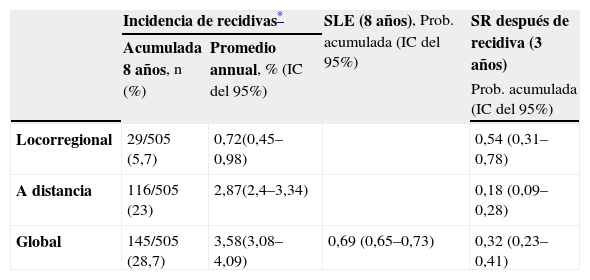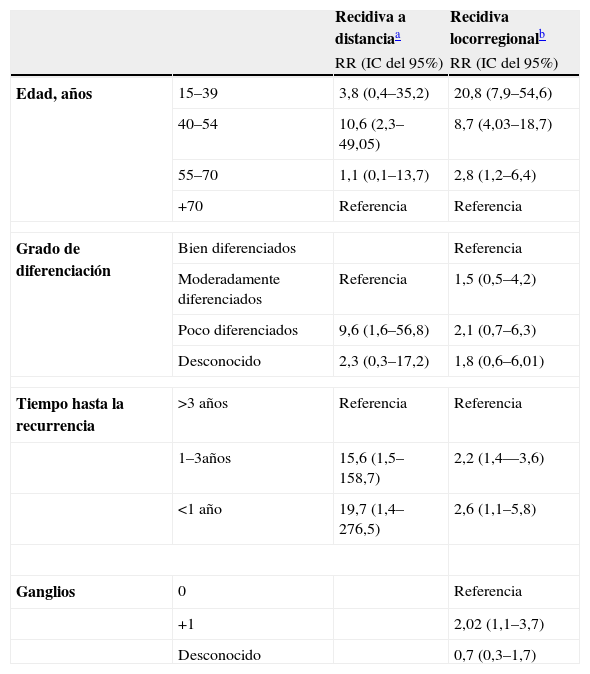Es variable la información existente sobre la incidencia y el pronóstico de las mujeres que tienen una recidiva del cáncer de mama. El objetivo fue medir la incidencia de recidivas locorregionales y a distancia y la supervivencia y sus determinantes después de la primera recidiva.
Pacientes y métodoTodas las mujeres residentes en Guipúzcoa, a las que durante los años 1995 y 1996 se les diagnosticó cáncer de mama invasivo y no diseminado, identificadas mediante el Registro de Cáncer de Gipúzcoa. Se midieron retrospectivamente las recidivas ocurridas hasta diciembre de 2004 y en 2007 se cruzó con el Índice Nacional de Defunciones para conocer la mortalidad. Se calculó la supervivencia relativa mediante el método de Hakulinen.
ResultadosSe incluyeron 561 mujeres con tumores en estadios i a iii. Un 42,6% fue tratado con cirugía conservadora más radioterapia, y en un 46,7% se realizó mastectomía. La mediana de seguimiento para la recidiva fue de 8 años. La incidencia de recidivas locorregionales fue del 5,7%, y la incidencia de recidivas a distancia fue del 23%. La mediana de seguimiento tras la recidiva fue de 6,1 años para las vivas y de 1,04 años para las fallecidas. La supervivencia a los 3 años fue del 54% (intervalo de confianza [IC] del 95%: 0,31 a 0,78) después de las recidivas locorregionales, y del 18% (IC del 95%: 0,09 a 0,28) tras recidiva a distancia. En el análisis multivariado, los factores que permanecen como predictores independientes de la supervivencia tras una recidiva locorregional son el tiempo hasta la recidiva, la edad y el grado de diferenciación del tumor inicial. La edad, el tiempo hasta la recidiva y la afectación ganglionar se han asociado a la supervivencia después de una recidiva a distancia.
ConclusionesLas mujeres que en el diagnóstico inicial sean menores de 54 años, con cortos períodos de tiempo libre de enfermedad, con tumores pobremente diferenciados y afectación ganglionar al inicio, constituyen un grupo de peor pronóstico y deben tenerse en cuenta a la hora de decidir su estrategia terapéutica en el momento de la recidiva.
Information regarding the incidence and prognosis of women who have suffered a recurrence of breast cancer is very variable. The aim of the present study was to determine the incidence of locoregional (LR) and distant recurrence and the survival and its determining factors after first recurrence.
Patients and methodsWe included all women resident in Guipuzkoa who were diagnosed with invasive, non-disseminated breast cancer during 1995 and 1996 identified via Guipuzkoa's Cancer Registry. Recurrences that occurred up to December 2004 were determined retrospectively and compared with the National Death Registry of 2007 to determine the mortality. Relative survival was calculated by the Hakulinen method.
ResultsFive hundred and sixty one women with tumours in stages I–III were included, 90% of whom were treated with conservative surgery+radiation therapy, or mastectomy. The median follow-up for recurrence was eight years, with 5,7% of these recurrences being LR and 23% distant metastases. The median follow-up after recurrence was 6,1 years for live patients and 1,04 years for dead ones. The three-year survival was 54% (95% CI: 0,31–0,78) after LR recurrence and 18% (95% CI: 0,09–0,28) after distant recurrence. Multivariate analysis showed that the factors that remained as independent predictors of survival after LR recurrence were time to recurrence, age and degree of differentiation of the initial tumour. Age, time to recurrence and nodal involvement were associated with survival after distant recurrence.
ConclusionsWomen younger than 54 at initial diagnosis with short disease-free periods and poorly differentiated tumours with nodal involvement have worse prognosis, which should be taken into account when deciding the therapeutic strategy to be followed upon recurrence.
Artículo
Comprando el artículo el PDF del mismo podrá ser descargado
Precio 19,34 €
Comprar ahora












